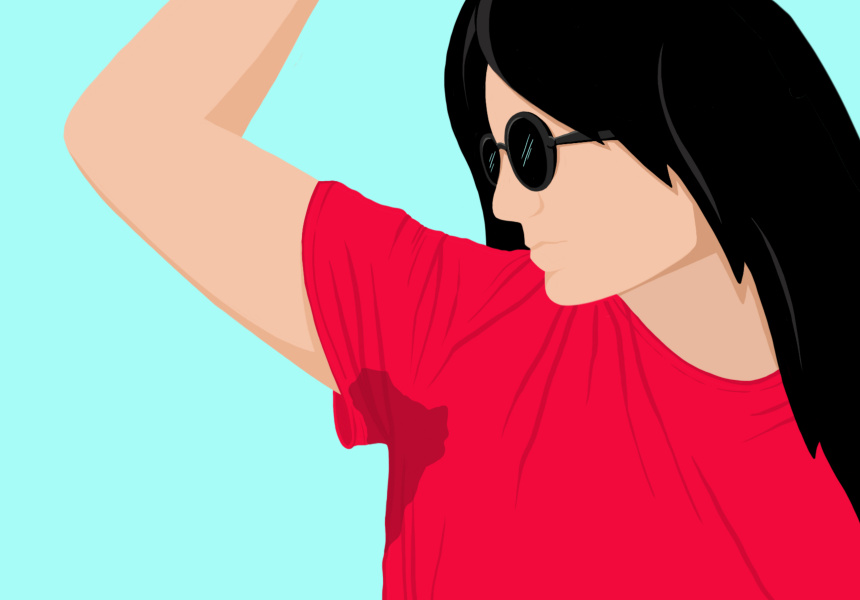Did your smartphone struggle to react to the tap of your sweaty finger on this article link? Read on. Did your partner shy away from the attempted grip of your clammy palm last night? We understand. Did you get up from your chair at lunch the other day and have to quietly wipe away the sweat marks your thighs left on the seat? Continue on.
You’re not the only one. “Sweat doctor” and associate professor of Sydney North Neurology Dr Karl Ng has had back-to-back appointments lately. He’s part of a group of clinics across the country, Sweat Doctors, dedicated to the treatment of sweating and hyperhidrosis, an excessive-sweating condition that affects roughly one in 35 Australians.
“Everybody sweats even if people don’t think they’re sweaty,” Ng tells Broadsheet. “It’s just a thermoregulatory function, and it comes out of every part of your body … The most common areas are underarms, hands and feet, and sometimes the head and neck regions.”
Never miss a moment. Make sure you're signed up to our free newsletter.
SIGN UP NOWNg says a number of things cause the sweats, namely anything that increases your heart rate, such as exercise, excitement, stress and a fight-or-flight trigger such as fear. It causes your internal temperature to rise, so your body’s natural response is to sweat in order to cool it down.
But “if they sweat at night, or if they sweat all over”, he says – basically without any trigger – those are the red flags to indicate the person might have an excessive sweating disorder, which is common.
Treatments can range from a change in lifestyle to alternative beauty treatments such as injections to the underarms. (Protein is injected to block the chemical signals from nerves that stimulate sweat production.) But before it gets that far, there are easy ways to reduce sweating and hide sweat marks day-to-day.
Fabric
“The more breathable the better,” says Sydney-based, Newcastle-raised women’s fashion designer Emma Mulholland.
“Cotton and linen and stuff like that are generally a lot better than thicker, manmade fabrics. Polyester’s going to be your worst nightmare,” she says.
This is because fabrics such as polyester, nylon, spandex, rayon, faux leather and faux fur are all made out of plastic. So not only are they choking the environment, they’re suffocating your skin, too.
Although polyester and nylon are designed to be lightweight, plastic fabrics don’t breathe as well as natural fibres do because they’re much more water resistant, which means sweat won’t evaporate, it’ll just continue to drip under your shirt. (You know how when you take your running shorts out of the washing machine they’re already practically dry? That’s because plastic repels water.)
And while your anti-sweat-mark failsafe fabric is denim – the thicker the better – because it won’t show sweat marks, your legs will be dripping on a 38-degree day under that heavy fabric.
Go loose
“Wear as little as you want and as you’re comfortable with,” says Mulholland.
This of course might be easier if you don’t have a job that requires you to don a suit and jacket. If you can, go sleeveless, strappy and loose.
Ng says wearing natural fabrics and looser clothing won’t just help reduce sweat marks, it will also decrease moisture. That means when the sweat evaporates your risk of fungal infections decreases.
Consider colour*
Mulholland says white and dark colours such as black and navy are the best colours to wear if you’re worried about underarm circles; lighter colours and greys show sweat the most.
But bear in mind, “black is going to make you hotter and make you sweat so it’s a shitty situation on both parts,” she says.
And patterns are handy, too. Tight, busy patterns such as gingham, as well as more abstract and multicoloured florals will hide sweat patches better than a solid colour.
Accessorise
After your morning shower, try swapping your moisturiser for a lightweight hydrating gel. Moisturisers don’t evaporate as well and can trap moisture on your skin.
Carry around a misting spray or a good ol’ spray bottle to brave the outside swelter. Keep them in the fridge before you head out and whenever you need to, give yourself a mist to cool down. Carry a fan to help dry off.
A water bottle is also your best friend because sweating equals dehydration. Plastic isn’t cool anymore, so invest in a sustainable thermos bottle that keeps water cold.
Deodorise
When it comes to buying deodorant, there are heavy-duty roll-ons you can buy over the counter at the pharmacy that boost the active antiperspirant ingredient. “They’ve got a higher dose of aluminium compounds, which essentially blocks the sweat pores,” says Ng.
And feel free to apply it all over your body (except your face). Ng says most people don’t realise you don’t have to restrict deodorant to your underarms, adding it is very effective on hands and feet.
Take a trip to Hobart
For some people it doesn’t matter where they are, they will sweat regardless, says Ng, but humidity can play a huge part for others.
Escape the heat and take your honey to a cooler, drier place this summer for maximum handholding. Or just hide out at an air-conditioned cinema, art gallery or flop in a body of water.
If you are concerned about the amount you sweat, consult a doctor, as although hyperhidrosis is not serious, excessive sweating could be a symptom or side effect of another condition or medication. Specialist Sweat Doctors clinics can be found in New South Wales, Victoria, ACT, Queensland and Western Australia, or consult your GP.
This article was originally published on December 17, 2018. It has been updated to reflect new information and remove out-of-date details.

